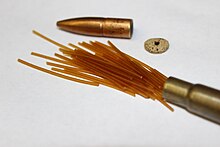Firearm propellant

Firearm propellants are a specialized type of propellant used to discharge a projectile (typically a bullet, slug, or pellets) through the barrel of a firearm. Mixtures of different chemical substances are often used to control the rate of gas release, or prevent decomposition of the propellant prior to use. Short-barrel firearms such as handguns necessitate faster-burning propellants to obtain sufficient muzzle energy, while long guns typically use slower-burning propellants. The pressure relationships between propellant chemical reactions and bullet response are described as internal ballistics.
Powder[edit]
Although all firearm propellants are generally called powder, the term gunpowder originally described mixtures of charcoal and sulfur with potassium nitrate as an oxidizing agent.[1] By the 20th century these early propellants were largely replaced by smokeless powder of nitrocellulose or similarly nitrated organic compounds.[2]
Black powder[edit]
The oldest gun propellant was black powder, a low explosive made from a mixture of sulfur, charcoal, and potassium nitrate. It was invented in China during the 9th century as one of Four Great Inventions, and still remains in occasional use as a solid propellant for antique firearms.[citation needed]
Smokeless powder[edit]
Modern firearm propellants however are smokeless powders based on nitrocellulose or similarly nitrated organic compounds, first invented in the late 19th century as a cleaner and better-performing replacement for black powder. Modern smokeless powder may be corned into small spherical balls, or extruded into cylinders or strips with many cross-sectional shapes using solvents such as ether, which can be cut into short ("flakes") or long pieces ("cords").[citation needed]
Mechanism[edit]
Many propellants use exothermic reactions to generate gaseous carbon monoxide, nitrogen and steam while raising temperatures to increase pressure.[3] The propellant reaction is initiated by a primer.[4] Pressure initially increases as the propellant is converted to gas, but starts to decrease as the bullet accelerates down the barrel to create a larger volume for the expanding gas. The accelerating force difference between chamber pressure behind the bullet and exterior pressure is initially reduced by static friction to move the bullet out of the cartridge casing into the barrel and then by sliding friction as the bullet moves down the barrel.[5] Pressure in small arms typically peaks between one-half and one millisecond after ignition. Handgun propellants may reach peak pressure before the bullet leaves the cartridge case, while rifle propellants may move a bullet several inches before reaching peak pressure.[6] The motion and behavior characteristics of projectiles while under the influence of the gases produced by the propellant is known as internal ballistics.[7]
Due to the relatively short distance a gun barrel can offer, the sealed acceleration time is very limited and only a small proportion of the total energy generated by the propellant combustion will get transferred to the projectile. The residual energy in the propellant gases gets dissipated to the surrounding in the form of heat, vibration/deformation, light (in the form of muzzle flash) and a prominent muzzle blast (which is responsible for the loud sound/concussive shock perceivable to bystanders and most of the recoil felt by the shooter, as well as potentially deflecting the bullet), or as unusable kinetic energy transferred to other ejecta byproducts (e.g. unburnt powders, dislodged foulings).[citation needed]
Characteristics[edit]
The performance characteristics of a propellant are greatly influenced by its grain size and shape, because the specific surface area influences the burn rate, which in turn influences the rate of pressurization. The term powder may be misleading, because firearm propellants are typically manufactured in grains of geometric shapes to physically control rate of gas production in accordance with Piobert's law.[8] Shotgun and handgun propellants may be flakes, while Improved Military Rifle propellants were extruded as short cylindrical tubes, and ball propellants are small spheres.[9]
Types of propellant[edit]
References[edit]
- ^ Sharpe, Philip B. (1953). Complete Guide to Handloading (Third ed.). New York: Funk & Wagnalls. pp. 133 & 137.
- ^ Davis, Tenney L. (1943). The Chemistry of Powder and Explosives. Hollywood, California: Angriff Press. pp. 287–330. ISBN 0913022-00-4.
- ^ Davis, William (January 1981). Handloading. Washington, D.C.: National Rifle Association. p. 28. ISBN 0-935998-34-9.
- ^ Sharpe, Philip B. (1953). Complete Guide to Handloading (Third ed.). New York: Funk & Wagnalls. p. 52.
- ^ Fairfield, A.P. (1921). Naval Ordnance. Annapolis, Maryland: United States Naval Institute. pp. 63–68.
- ^ Davis, William (January 1981). Handloading. Washington, D.C.: National Rifle Association. p. 125. ISBN 0-935998-34-9.
- ^ Smith, Selwyn D. (1965). Interior Ballistics of Guns. Washington DC: United States Army Material Command. p. 1-2.
- ^ Russell, Michael S. (2009). The Chemistry of Fireworks. Royal Society of Chemistry. p. 45. ISBN 978-0854041275.
- ^ Wolfe, Dave (1982). Propellant Profiles. Vol. 1. Prescott, Arizona: Wolfe Publishing Company. pp. 3, 15 & 136. ISBN 0-935632-10-7.
- .
